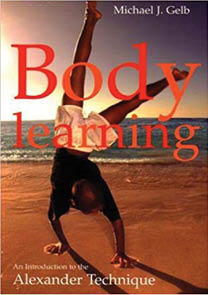The Alexander Technique addresses inefficient habits of movement and patterns of accumulated tension that interfere with our innate ability to move easily. In his book, Body Learning, Michael J. Gelb notes that the technique itself is difficult to define because it involves a new experience. He says, “It’s like trying to explain music to someone who has never heard a note.”
Rather than passive treatment, it’s an active exploration that changes the way one thinks and responds to activity. It can be applied to sitting, lying down, standing, walking, lifting, and other daily activities. For example, a violinist’s stiff shoulders and arms may impede a pleasing sound, while a singer’s tight neck or jaw will cause the voice to become less resonant.
The Alexander Technique can release undue tension in the body to create a more fluid, lively, and less tense and rigid performance. By improving the quality of the physical movements involved in playing an instrument or singing, the technique can also boost the quality of the music itself.
The Alexander Technique has a history of helping musicians and singers perform with less stress and fewer injuries. It has been used and endorsed by renowned musicians and celebrities, including Paul McCartney, Sting, violinist Yehudi Menuhin, and many others.
From Shakespeare to Sting
The Australian F.M. Alexander (1869-1955), a Shakespearean actor who kept losing his voice during performances, first developed the method when his doctors could not help him. As he embarked on a journey of self-discovery through movement, he realized that excess tension in his neck and body were causing his problems and he began to explore new ways of speaking and moving with greater ease.
Following Alexander’s success in improving his own situation, his friends, and even several of the doctors he had consulted earlier, persuaded him to teach others what he had learned. He refined his method of instruction over more than 50 years, and eventually trained others in what became known as the Alexander Technique.
Practical Applications
Martha Hansen Fertman, director of The Philadelphia School for the Alexander Technique says, “Musicians make the best students. They are so dedicated and the work becomes so pertinent.”
But she says that musicians don’t need to be experiencing pain or discomfort to benefit from the Alexander Technique. “It is not just for issues around pain,” she clarifies. “It’s for overall musicianship and being able to technically do what it is that musicians need to do. It’s not only for physical therapy—it is a much deeper study.” An Alexander teacher’s focus is on the musician’s overall coordination, which can help prevent future injuries.
“With a guitarist, for example, the shoulder strap may be causing them to ‘pull down’ and interfere with their overall use,” she says. “It’s the same with a person sitting down and playing guitar. Guitarists tend to wrap themselves around their instruments, which interferes very much with their overall coordination, as well as the mobility and suppleness of their fingers.”
Fear and anxiety also creep into the mix. “They stiffen up and they fall back into all of their worst habits of misuse and they interfere with themselves,” she notes. Recognizing when and how that happens is an essential component of the training. Why it happens is a bit more complex, and can be associated with a musician’s personal history, including psychological issues, she explains.
“Alexander Technique tends to work in small increments of change and a healthy person can manage the levels of change—they don’t need me to help them through it,” she says. “And if they do need help, I refer them to a psychologist because we are dealing with the habits of a lifetime.”
Commitment to change is essential, says Fertman. If someone is told they should try the Alexander Technique to help them play better, and they don’t really want to, it’s not going to do much good. “Whereas for someone who plays piano, who has developed a great deal of pain in their forearm and has difficulty playing—their commitment to understand and change is vital,” she asserts.
The length of time it takes to see improvement depends on your level of involvement. “You can go on learning and finding out new ease and freedom for the rest of your days on earth,” she says. “And if you stop interfering with yourself, your very best will come through. You’ll realize your potential.”
Body Learning: An Introduction to the Alexander Technique, by Michael J. Gelb
Body Learning supplies answers to the most commonly asked questions about the Alexander Technique and a glossary of significant terms, as well as a guide to dynamic relaxation. Qualified Alexander Technique teacher Michael Gelb provides inspiration and guidance for newcomers to the technique and conveys a full understanding of the complex mental and physical dynamics involved.


